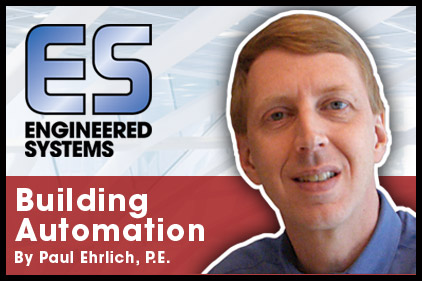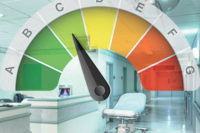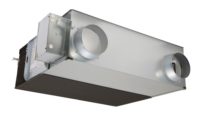The application of energy recovery units allows for the ability to do total heat recovery and recover both sensible and latent heat from an exhaust air stream, using that heat to pre-condition outdoor air required for building ventilation.
In addition to saving energy, the use of an energy recovery unit (ERU) also allows for the ability to downsize equipment, potentially reducing project costs. While it makes sense to consider using an ERU for any project where there is supply and exhaust air, it is par-ticularly desirable for applications that require a large percentage of outdoor air. One example of this type of application is a large assembly area, such as a school cafeteria or gym that may require ventilation for several hundred occupants. For new construction the use of ERU’s is required under ASHRAE 90.1.
On the vast majority of existing building projects that we work on, we find that the ERU has been designed to operate anytime the air handler is in the occupied mode. Operating in this manner is not always optimal, since we end up always recovering energy from the exhaust air even when we don’t want to. Ideally, energy recovery should only be used when the outdoor air is either hot or cold and we can use the recovery to pre-heat or pre-cool the incoming air stream. So here are a series of rules to consider when writing sequences for new and existing ERU applications:
- Economizer. If conditions are right to do free cooling with outdoor air, and the building has the ability to utilize an air side (or water side) economizer, we do not want to be using energy recovery and instead want to bypass the unit if possible (or at least stop the energy recovery). Economizer changeover is usually determined based on outdoor air dry bulb or enthalpy, often with a comparison against the return/exhaust air. Continuing to operate energy recovery while in economizer mode results in adding heat load to the outdoor air stream and increasing overall energy usage.
- Heating mode. If the air handler is in the heating mode, then we generally want to operate the energy recovery unit and get as much heat from the exhaust air stream as possible.
- Cooling mode. If the unit is in the cooling mode and we are utilizing the economizer (see above), then we do not want to do energy recovery. On projects that are using dry bulb changeover for economizer, we generally will keep the energy recovery off until the outdoor air temperature starts to approach the return air temperature. That way, we can avoid adding heat to the outdoor air when it is in the range of 55–70 degrees DB.
- Frost control. In cold climates, special consideration should be given to sensing for frost build-up on the wheel during extremely cold weather and allowing the coil to defrost using exhaust air.
Ideally, the ERU can be equipped with a bypass damper, which allows for air to be bypassed around the wheel (or the unit) when we don’t want to be doing energy recovery. On many existing units, there is not a bypass available. In that case, we generally will operate the supply and return fans at all times when the air handler is in operation, but we will shut off the rotation of the enthalpy wheel when we do not want to be doing energy recovery. In order to keep the wheel from building up with dirt and moisture, we “stir” the wheel (which involves turning it on for a few minutes each hour).
Utilizing a variable speed motor for the wheel rotation and then modulating the wheel velocity based on discharge temperature is the ideal way to control an ERU. But of course, this adds cost and complexity, and other than systems where you are doing demand controlled ventilation and dynamically varying the amount of outdoor air, this is probably not a firm requirement.
Used properly, energy recovery is an important tool for managing ventilation and energy efficiency. But as with many other systems, proper control can make a large difference in the resulting efficiency and performance.








